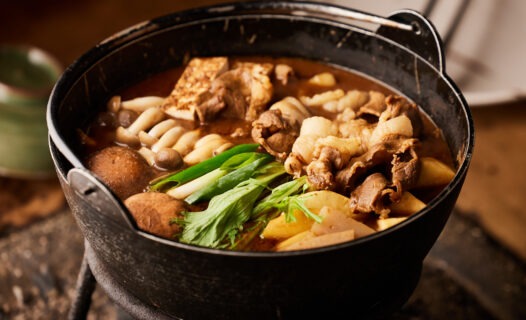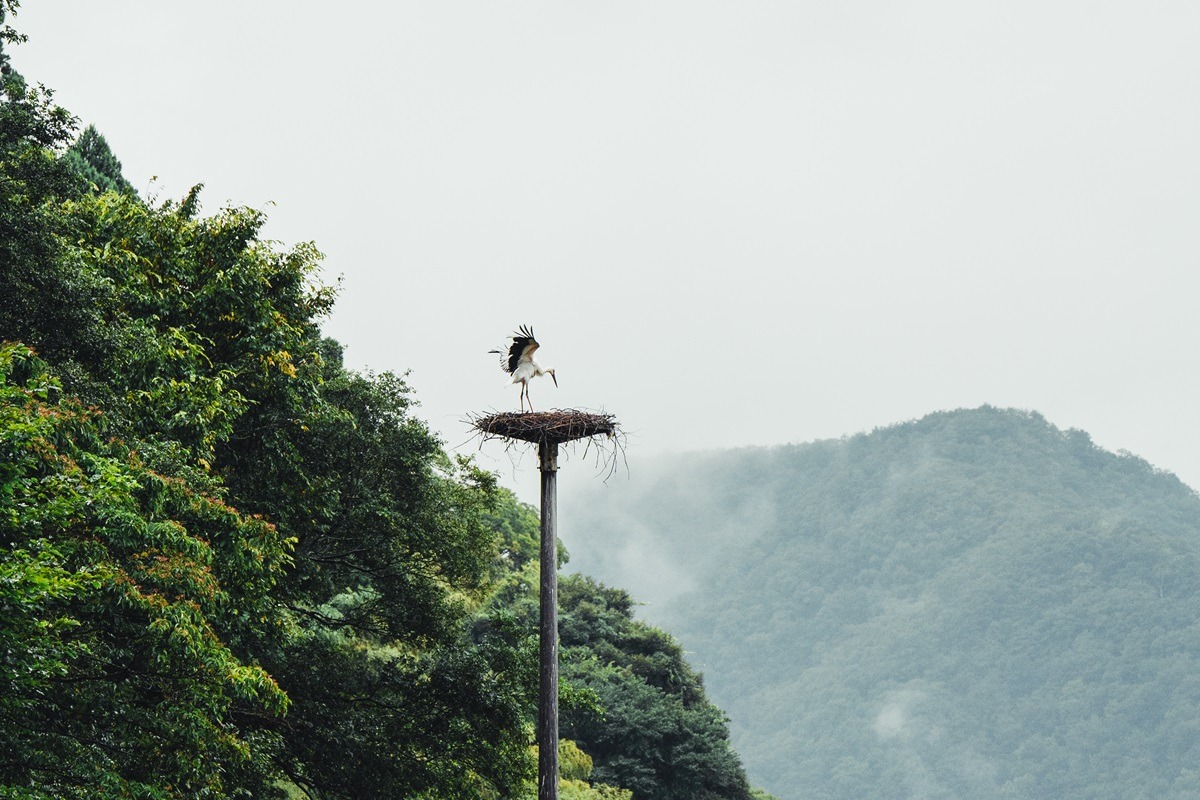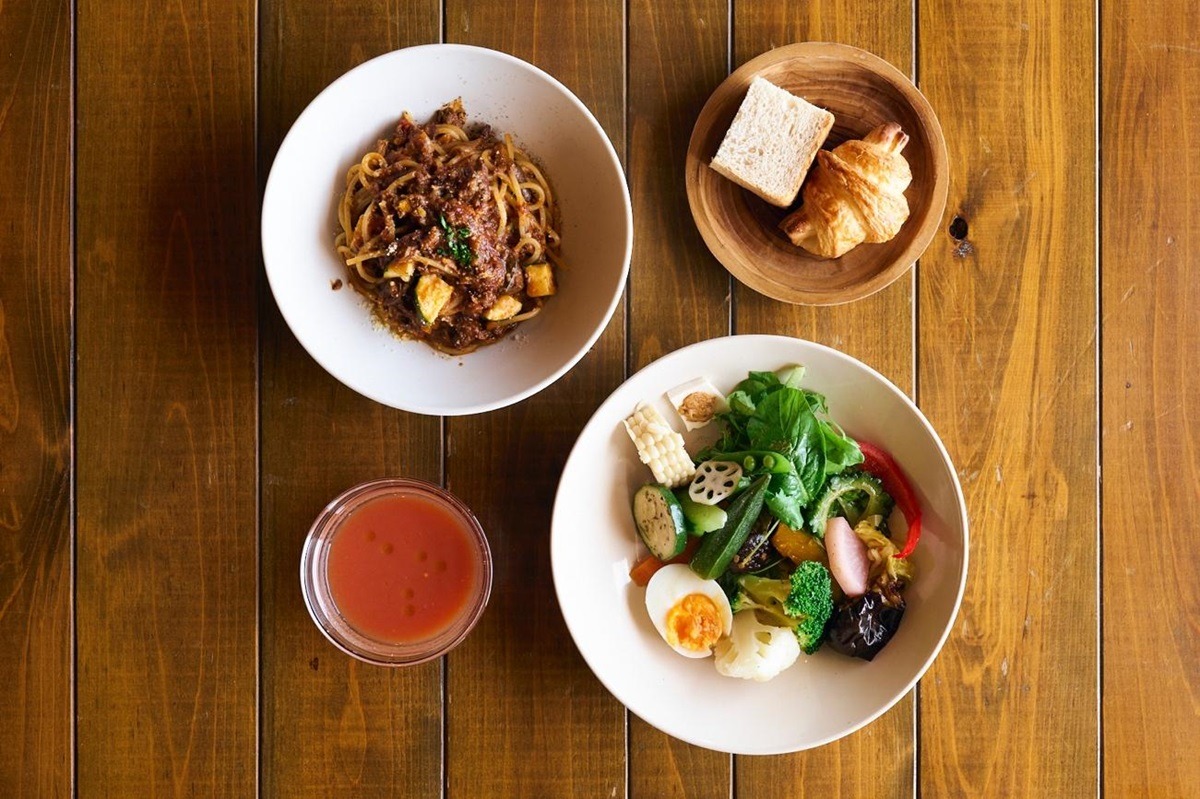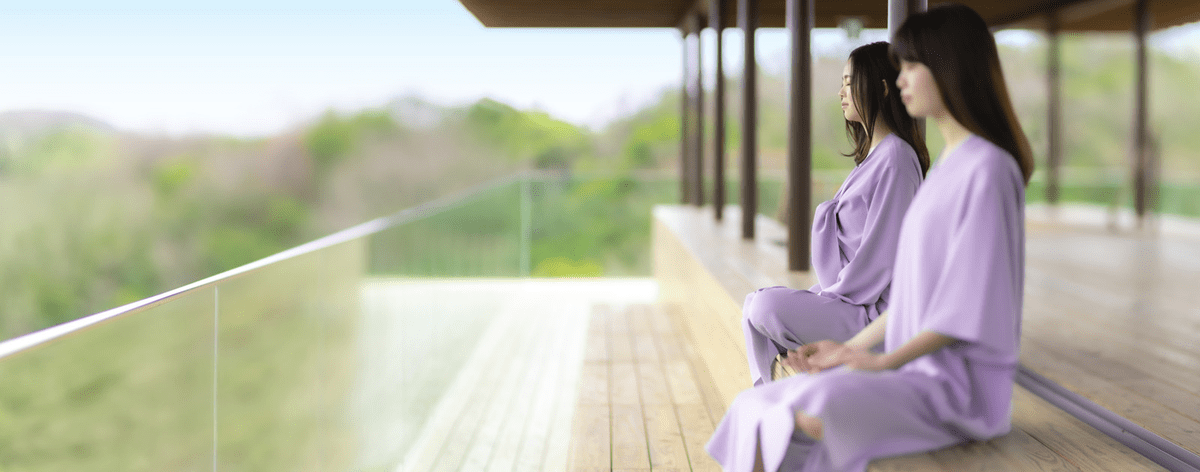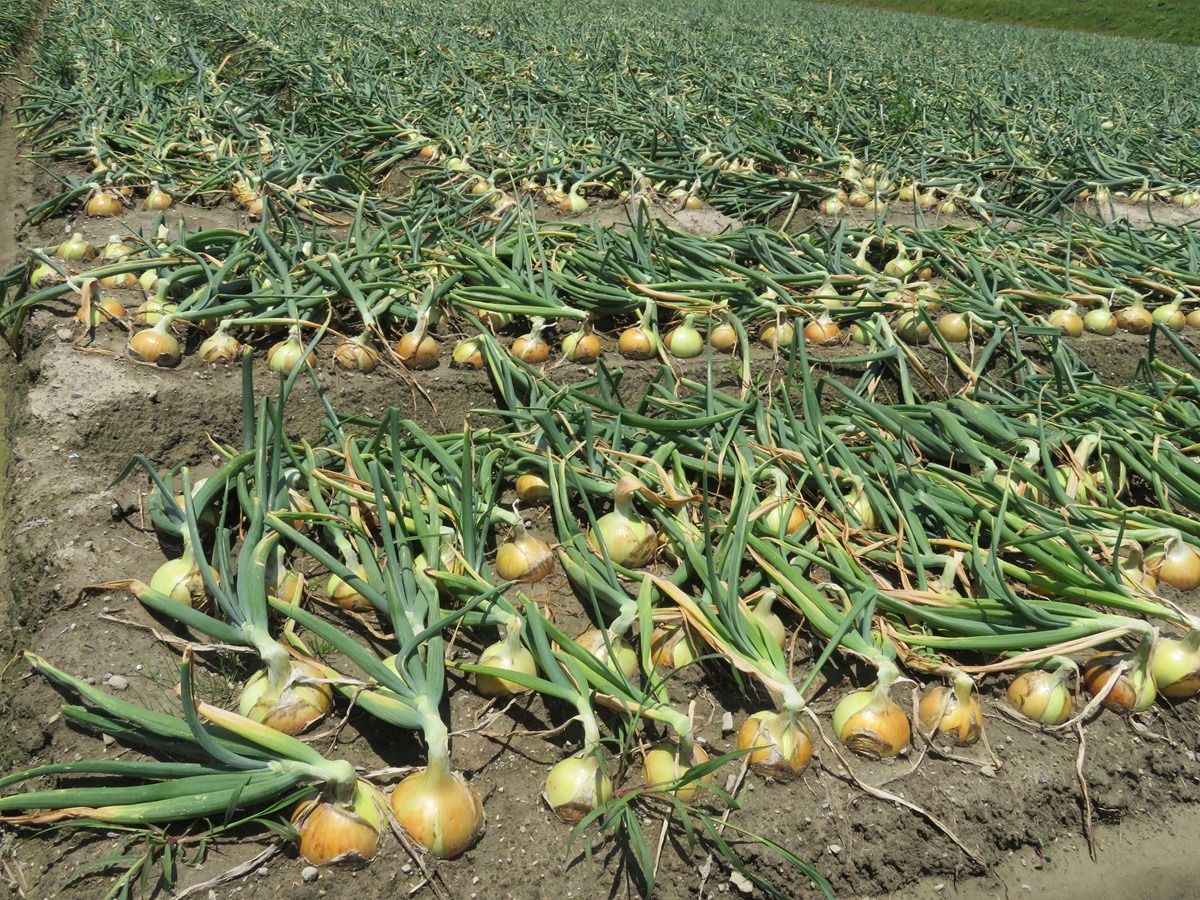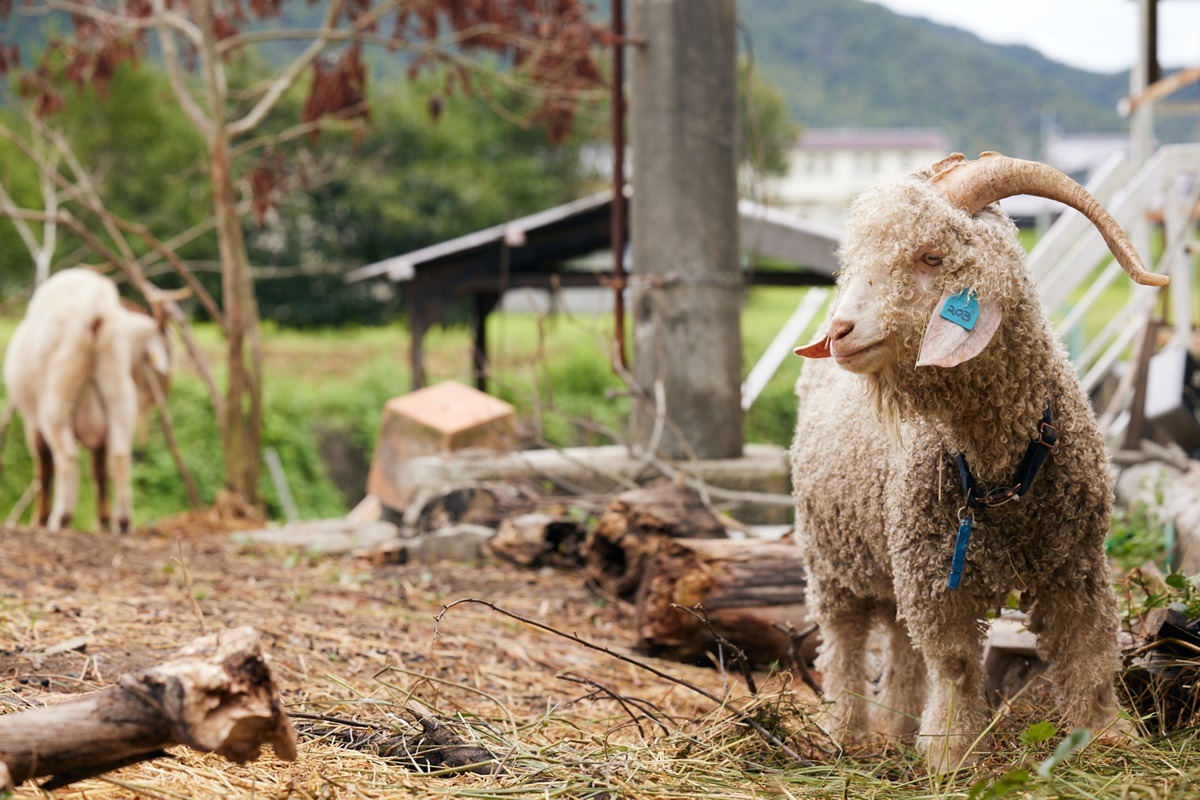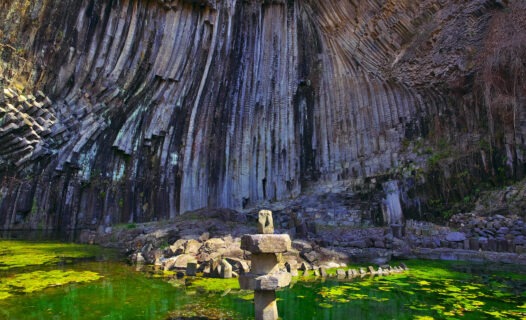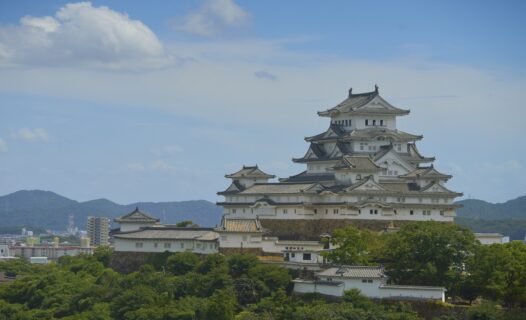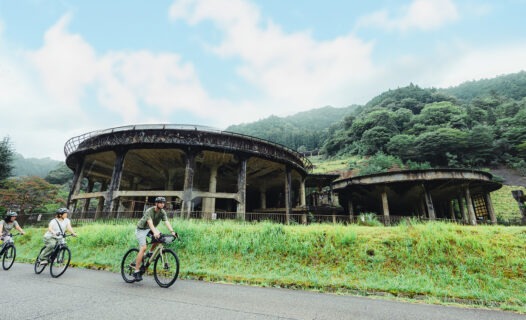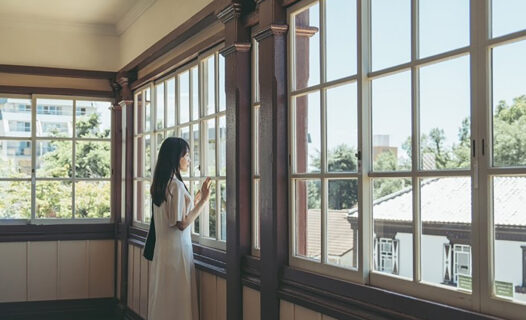Hyogo Prefecture, blessed with a plethora of diverse landscapes, is often called a “microcosm of Japan.” Offering unique travel experiences that immerse visitors in the region’s distinct ecosystems, culture, and cuisine, the journey outlined below takes you through globally rare stork habitats to sensory Zen retreats and farm-to-table restaurants on Awaji Island to enjoy while rejuvenating mind and body—not to mention the many one-of-a-kind “Made in Hyogo” products on offer, such as comfortable wear crafted from Nishiwaki City ’s traditional Banshu-ori textiles, perfect as souvenirs.
A Sustainable Town Where Humans and Storks Coexist: Hyogo Prefecture’s Toyooka City
An oriental white stork descending onto an artificial nest towerIn the past, Konotori (oriental white storks) disappeared from Japan due to the loss of their natural prey, such as frogs, caused by the use of chemical fertilizers and pesticides. Hyogo Prefecture’s Toyooka City, their last habitat, launched the world’s first Oriental White Stork Reintroduction Promotion Plan in 2003. By restoring the rivers, farmland, and Satoyama woodland (secondary woods characteristic to Japan) landscapes, Toyooka successfully reintroduced the oriental white stork to the wild in 2005.
Hyogo Park of the Oriental White Stork, home to many storksAs of August 2024, around 400 storks now live in the wild across Japan, frequently seen in Toyooka City’s rice fields, the Maruyama River basin, and the Hachigoro Toshima Wetland. Although absent from the wild during certain seasons, the Toyooka Municipal Museum of the Oriental White Stork offers year-round viewing of oriental white storks under care.
The “Genbudo Kago Temari Musubi Set” made with Konotori riceHyogo’s commitment to sustainability extends to food with Konotori rice, cultivated without pesticides, as part of an initiative using the “Konotori hagukumi” farming method that supports their reintroduction. You can enjoy this sustainable delicacy on the guided Oriental White Stork Observation Tour that includes stork-spotting and a lunch featuring Konotori rice—and by staying overnight in Toyooka or Kinosaki Onsen, you might just heighten your chances of encountering these majestic birds!
Farm-to-Table Dining with Awaji Island’s Eco-Grown Brand Vegetables
The farm restaurant Haru San SanAwaji Island, situated in the eastern Seto Inland Sea, is renowned for its agricultural abundance, boasting a food self-sufficiency rate exceeding 100%. Known for onions, lettuce, beef, milk, sea bream, and hamo (pike conger eel), the island opened Awaji Nature Lab & Resort in 2021, embodying the philosophy that “true wealth resides in food.” The expansive 38,000-square-meter sustainable garden in northern Awaji champions eco-friendly farming practices.
Inside the restaurant Haru San SanAt its heart is Haru San San, a farm-to-table restaurant that epitomizes the essence of sustainable agriculture. Surrounded by lush fields where vegetables are cultivated through circular farming practices, the unique dining experience here invites visitors to savor the flavors of the land.
Designed by renowned architect Shigeru Ban, a Pritzker Prize laureate celebrated for his innovative use of paper tubes in disaster relief housing, Haru San San is a masterful blend of tradition and modernity. The building incorporates traditional thatched-roof techniques with Ban’s signature eco-conscious design, featuring a hybrid structure of recycled paper tubes and minimal timber. The result is a sturdy yet light, environmentally mindful space that seamlessly blends craftsmanship with sustainability.
The popular “Haru San San Set”The most popular menu item is the Haru San San Set, which emphasizes vegetables as a main. A vibrant appetizer salad features about 16 types of seasonal vegetables, each prepared differently to highlight their textures. The dish is finished with locally sourced Awaji Island salt to enhance the vegetables’ natural flavors. The gazpacho, thickened with vegetable remnants, is a rich blend of non-standard tomatoes and carrots, offering a rich, bold taste. Their fresh pasta Bolognese, generously topped with Awaji beef, is another must-try.
Looking ahead, the resort will open 11 cottages designed by different architects, offering a “farm-inclusive lifestyle” experience. Each cottage will have an adjoining garden, allowing guests to enjoy next-generation farming practices while staying mindful of their health and the environment.
A Mindfulness Experience to Free Your Mind and Body in Nature
The retreats wooden structure emanates a sacred, temple-like atmosphere.Nestled within Awaji Island’s lush nature, Zenbo Seinei is a Zen retreat also designed by Shigeru Ban. The prominent architect is known for projects like the Centre Pompidou-Metz in Paris and the Fujisan World Heritage Center in Shizuoka, and globally celebrated for his innovative use of wood in modern architecture.
Situated along Japan’s standard meridian at 135 degrees east, the retreat features a striking 100-meter-long wooden deck constructed from Japanese cedar. The first floor houses a lounge, 18 guest rooms, and a communal salon, while the second floor offers a serene space for Zen, meditation, and yoga, providing a sustainable way to harmonize both body and mind.
“Zenbo cuisine,” overseen by a fermentation and brewing specialistMeal plans emphasize Japan’s traditional fermentation culture, offering gentle, plant-based “Zenbo cuisine” free of animal products, wheat, oil, and sugar. Enjoy the tranquil views of Awaji Island’s expansive scenery as you reset your mind and body in this tranquil environment.
A Hands-On Tour of SDG-Oriented Farming Practices for a Sustainable Future
Onion fields ready for harvestIn anticipation of Expo 2025 Osaka, Kansai, Hyogo Prefecture has launched the Hyogo Field Pavilion, a prefecture-wide initiative for locals to showcase regional attractions. Awaji Island hosts 19 field pavilions, including the “Hometown of Awaji Island Onions! Minami Awaji City Japan Agricultural Heritage Tour.”
In this village, farmland surrounds a large central ranch.Designated as a Japanese Nationally Important Agricultural Heritage System, this region’s farming system integrates rice and onion cultivation with livestock farming, forming a sustainable production cycle dating back over 100 years. Rice straw is fed to dairy cows, whose manure is composted to enrich the soil.
The system shapes the distinctive landscape of Minami Awaji, featuring reservoirs built 1,700 years ago to combat water shortages, “onion sheds” for sun-and-wind drying, and nagaya-mon longhouse gates with integrated cattle barns. Breathing in the fresh country air while strolling through the picturesque village, where a historic traditional production cycle lives on still, is one of the highlights of this tour.
An onion shed featuring Awaji tiles, one of Japan’s top three most famous types of roof tile.During harvest season, visitors can join farmers in the fields to pick onions and enjoy their fresh, sweet taste right on the spot. After a scenic village walk, participants can make onion jam, which can be enjoyed drizzled over chiffon cake and gelato made with freshly squeezed milk from a nearby dairy farm.
The two-hour tour accommodates one group of up to five people per day.As you savor the natural sweetness of Awaji’s onions, you’ll gain a deeper appreciation for the unique landscape of Minami Awaji that nurtures their flavor—the ultimate sweet indulgence in nature.
Eco-Friendly Materials: Vibrant Banshu-Ori, a Legacy from the 18th Century
Banshu-ori is a traditional cotton textile with a history that dates back to the late 18th century, originating from the Banshu region in western Hyogo Prefecture, including Nishiwaki City and Kato City.
Banshu-ori yarnA distinctive feature of Banshu-ori is its yarn-dyeing process, which brings out rich, vibrant colors.
Original color yarns individually hand-dyed by textile artistsNatural dyes are often used for Banshu-ori, making it an eco-friendly material. Its soft texture has helped it find popularity as a choice for clothing and household items.
The tamaki niime storeLocated in Nishiwaki City, tamaki niime continues this long tradition, creating and selling various Banshu-ori items, from shawls and dresses to long shirts. Each piece is entirely one-of-a-kind, and with all design, production, and sales handled in-house, the company attracts young artisans dedicated to passing on this traditional craft to future generations.
Sheep raised at tamaki niime.The tamaki niime also runs a sustainable project involving sheep and alpacas for wool production and grows its own cotton, ensuring full control over materials and resources.
